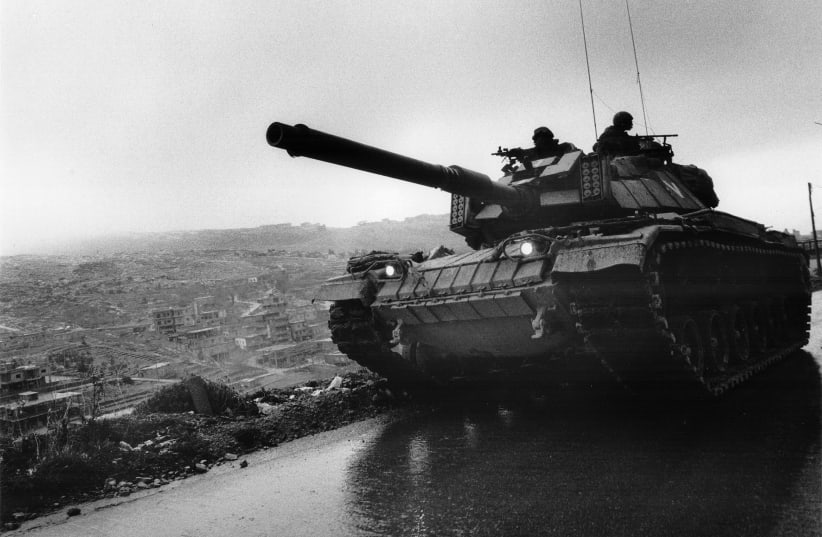The Defense Ministry has released never-before-seen footage of troops inside Lebanon ahead of the 40th anniversary of the First Lebanon War, known as Operation Peace for the Galilee.
“The IDF Archives and defense establishment have in recent days carried out a process of digitizing and exposing hundreds of hours or rare video footage taken during the war,” the ministry said, adding that the footage was just the first of many more chapters.
In the black-and-white footage, dozens of troops are seen gathered on top of armored personnel carriers and tanks as they head into Lebanon. Other troops are seen sitting together and receiving orders.
In other parts of the footage in color, troops can be seen removing ammunition from their tank as they chase armed terrorists in an orchard.
In another segment, Col. Shmuel Arad is seen describing a clash between IDF soldiers and Syrian forces.
“The terrain is hard terrain. The height differences are very great and the confrontation was with terrorist forces... with Syrian commando troops, the Syrian anti-aircraft systems, Syrian tanks and engineering forces,” he said.
In the footage released on Sunday, IDF tanks and troops are seen engaged in urban combat with troops firing mortars and other ammunition. IDF jets carrying heavy munitions are also seen taking off from bases heading out on missions.
In a change of pace from the deadly war, IDF troops are also seen enjoying the snow, including building a snowman as their rifles are piled nearby. Other everyday scenes of troops making coffee, eating and singing are also seen in the footage.
Former prime minister Menachem Begin can be seen in the archival footage as can Ariel Sharon, who served as defense minister during the war.
The decision by Begin and Sharon to launch the war came after an assassination attempt in June 1982 against Israel’s ambassador to Great Britain Shlomo Argov by a terrorist who belonged to the Abu Nidal group.
Dozens of Katyusha rockets were fired toward communities in northern Israel by Palestinian terrorist groups in southern Lebanon in the early 1980s. However, Israel launched Operation Peace for the Galilee following the attempt on Argov’s life.
The day after the attempted assassination, IDF jets struck nine targets in Lebanon, including two in Beirut. Terrorists then retaliated with intensive bombardments on communities in the Galilee region.
The IDF was then given the order to secure the communities with the objective of the war being to push terrorists, including Syrian forces, out of southern Lebanon and out of range of the communities of northern Israel by 40 km.
THE WAR LASTED more than three months until IDF troops reached Beirut. A total of 1,216 IDF troops were killed between June 5, 1982, and May 31, 1985.
Nevertheless, the war failed to achieve its full objective, and in 1984, the military was ordered to withdraw from Lebanon.
While the army withdrew from most of the country in 1985, a token force was left to keep control of a 1,000-sq.km. security zone 20 km. deep until 2000 to prevent terrorist attacks, which had plagued the civilians of the North in the ’70s and ’80s.
The IDF announced last year that it would recognize Israel’s 18-year occupation of southern Lebanon as an official military campaign.
During a ceremony last June in which troops who served in the security zone received a campaign medal, IDF Chief of Staff Lt.-Gen. Aviv Kohavi said the First Lebanon War and the IDF’s time in the security zone in Southern Lebanon “shaped the northern arena, and to a large extent radiated and influenced the entire Middle East.”
Kohavi told the crowd that the ceremony and the campaign medal “are not just an external sign,” but that they “embody appreciation and respect” as well as a “national and moral obligation” by the State of Israel for those who served there.
The “long years of operational activity also shaped generations of soldiers and commanders, shaping units, norms and methods of operation. For the generation of commanders that I and the members of the General Staff belong to, Lebanon was our school for war,” he said. “It was as sharp as a sharpened knife, from time to time wounding us, but most of the time we were sharpened on its blade. There we developed combat methods, faced a changing battlefield, and developed anti-guerrilla fighting methods.”
Though official numbers put IDF casualties at 256, with roughly two dozen soldiers killed per year from 1985-2000, the unofficial number stands at 675. That number does not include those who were wounded during their time in Lebanon, and it does not take into account all those who came back with psychological wounds.
Israel again went to war in Lebanon in 2006, after Hezbollah ambushed IDF troops, sparking the 34-day Second Lebanon War, during which Israel lost 121 soldiers and 43 civilians.
